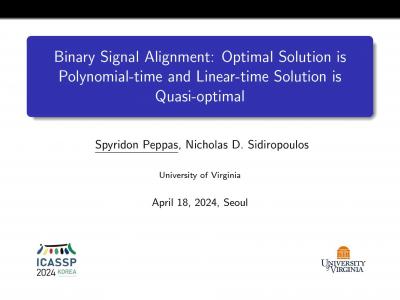Documents
Presentation Slides
Binary Signal Alignment: Optimal Solution is Polynomial-time and Linear-time Solution is Quasi-optimal

- DOI:
- 10.60864/t68a-ew52
- Citation Author(s):
- Submitted by:
- Spyridon Peppas
- Last updated:
- 6 June 2024 - 10:22am
- Document Type:
- Presentation Slides
- Document Year:
- 2024
- Event:
- Presenters:
- Spyridon Peppas
- Paper Code:
- SPCOM-L4.3
- Categories:
- Log in to post comments
In this paper we revisit a recently proposed underlay communication scheme which relies on repetition of the secondary signal at the transmitter and canonical correlation analysis CCA at the (multi-antenna) receiver. In this setting, CCA can provably extract the underlay signal in the presence of potentially strong and time-varying primary interference, without any channel knowledge. At its core, the concept relies on embedding the signal of interest in two distinct mixtures or ``views'', thus exploiting signal alignment as opposed to interference alignment, which is far less practical. In earlier work, the signal of interest was treated as analog for the purposes of CCA, and projected onto the finite alphabet after extracting it from interference. In this contribution we incorporate a binary symbol constraint directly into the CCA optimization formulation. We show two surprising results: that the resulting binary signal alignment problem can be optimally solved in polynomial time, and that a linear-time two-step solution is very close to the optimal one, for all practical purposes.

